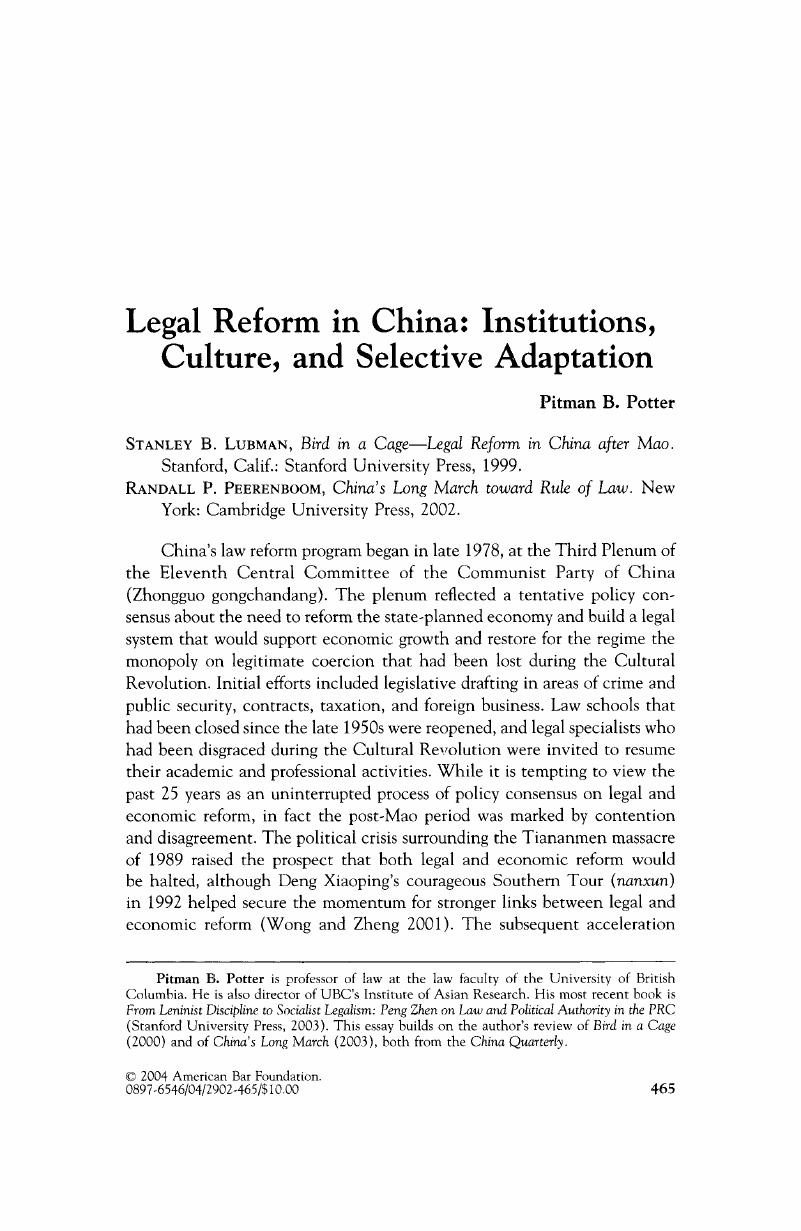Crossref Citations
This article has been cited by the following publications. This list is generated based on data provided by Crossref.
Potter, Pitman
2006.
China and the Human Right to Health: Selective Adaptation and Treaty Compliance.
SSRN Electronic Journal ,
Michelson, Ethan
2006.
Dear Lawyer Bao: Everyday Problems, Legal Advice, and State Power in China.
SSRN Electronic Journal,
Biukovic, Ljiljana
2007.
Compliance with International Treaties: Selective Adaptation Analysis.
Canadian Yearbook of international Law/Annuaire canadien de droit international,
Vol. 44,
Issue. ,
p.
451.
KSHETRI, NIR
2007.
INSTITUTIONAL CHANGES AFFECTING ENTREPRENEURSHIP IN CHINA.
Journal of Developmental Entrepreneurship,
Vol. 12,
Issue. 04,
p.
415.
Michelson, Ethan
2008.
Dear Lawyer Bao: Everyday Problems, Legal Advice, and State Power in China.
Social Problems,
Vol. 55,
Issue. 1,
p.
43.
2008.
The Rapidly Transforming Chinese High-Technology Industry and Market.
p.
243.
Kshetri, Nir
and
Ajami, Riad
2008.
Institutional reforms in the Gulf Cooperation Council economies: A conceptual framework.
Journal of International Management,
Vol. 14,
Issue. 3,
p.
300.
Nakamura, Masao
2008.
Changing Corporate Governance Practices in China and Japan.
p.
235.
Goo, S. H.
and
Carver, Anne
2008.
Changing Corporate Governance Practices in China and Japan.
p.
206.
Kshetri, Nir
2009.
Institutionalization of intellectual property rights in China.
European Management Journal,
Vol. 27,
Issue. 3,
p.
155.
Kshetri, Nir
2009.
Entrepreneurship in post-socialist economies: A typology and institutional contexts for market entrepreneurship.
Journal of International Entrepreneurship,
Vol. 7,
Issue. 3,
p.
236.
Carter, Justin
2010.
The Protracted Bargain: Negotiating the Canada–China Foreign Investment Promotion and Protection Agreement.
Canadian Yearbook of international Law/Annuaire canadien de droit international,
Vol. 47,
Issue. ,
p.
197.
Fukunaga, Yuka
2010.
International Economic Law and National Autonomy.
p.
22.
SHIH, MI
2010.
The Evolving Law of Disputed Relocation: Constructing Inner‐City Renewal Practices in Shanghai, 1990–2005.
International Journal of Urban and Regional Research,
Vol. 34,
Issue. 2,
p.
350.
Harpaz, Marcia Don
2010.
Sense and Sensibilities of China and WTO Dispute Settlement.
SSRN Electronic Journal,
Harpaz, Marcia Don
2010.
Sense and Sensibilities of China and WTO Dispute Settlement.
SSRN Electronic Journal,
Zurn, Michael
Nollkaemper, Andre
and
Peerenboom, Randall
2011.
Rule of Law Dynamics in an Era of International and Transnational Governance.
SSRN Electronic Journal,
Nakamura, Masao
2011.
Adoption and policy implications of Japan’s new corporate governance practices after the reform.
Asia Pacific Journal of Management,
Vol. 28,
Issue. 1,
p.
187.
KSHETRI, NIR
2013.
THE DIASPORA AS A CHANGE AGENT IN ENTREPRENEURSHIP-RELATED INSTITUTIONS IN SUB-SAHARAN AFRICA.
Journal of Developmental Entrepreneurship,
Vol. 18,
Issue. 03,
p.
1350021.
Li, Xueyao
and
Cheng, Jinhua
2013.
Structural Constraints on Legal Change: Chinese Lawyers in the Interaction between the State, the Market and Society.
SSRN Electronic Journal,



